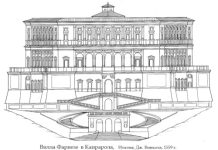Perhaps we can say that symmetry is a kind of universal code by which information from the outside world is translated into an artificially created environment and decoded again when it is perceived.
This role of symmetry is based on the “global similarity” of aspects of the universe and reveals a number of meanings of the concept itself in the field of architecture. We are talking about the extension of the concept of symmetry to the description of the principles of professional compositional thinking.
These principles of symmetry are conditioned by the totality of connections and relationships in culture, which gave them the content and meaning, which we are trying to comprehend when observing a symmetrical structure.
This aspect allows us to consider symmetry not only as a visual regularity of geometry or as a regularity of socio-cultural prerequisites, but at the same time as a process, sequence of construction, ordering, bringing to the whole, order, system, etc. Abstract, abstract theoretical thought schemes are also meant, the structural orderliness of which accompanies the creation of architectural symmetry, meaning those processes that, in essence, occur in the professional mind when translating information received in any code into the language of graphics. But not only that. The orderliness of thought, its symmetry, is characteristic of any intelligent activity.
“Disunity and disorder are unbearable for the spirit; thought longs for a system and gets it first of all in language.” This remark, made by a researcher-wordsmith, in fact reflects the commonality of all types of art, where the artistic impulse is directed to understanding, creation, etc., whether it be literature, music, architecture.
It is difficult to name the rule by which an author has an idea of a work. To look for it means to partly fall into schematism.
Creative thought is confused, capricious, but it has its own repetitions, its own rhythms, its own preferences. It is not accidental for this consciousness, because it is based on the independent experience of the individual. The principles of creativity, the selectivity of the author’s memory predetermine the compositional structure of the architectural idea, which is implemented with the help of specific methods of drawing. Actually, the torments of creativity consist in the search for methods of expression adequate to the artistic idea.
This connection is, in essence, a symmetrical correlation of verbally formulated ideas and project graphics, their identity in semantic terms. Symmetry manifests itself in a variety of modifications at all stages of the project’s life, sometimes unconscious as such, but as a methodical reality, as a means of widely understood ordering.
Artistic consciousness operates with analogies, associations, semantic and emotional comparisons, seeks to streamline visual and spiritual experience. Here, symmetry as a kind of canvas allows us to correlate verbal theses and their graphic fixation.
Symmetry is included in the science of art in the broad sense of this term as a theory of artistic transformations and invariants. It is used in this capacity twice: at the primary (elementary) level of artistic objects and processes as a method of identifying the structural ordering of equivalent (in some sense) elements of artistic structures; at the highest (metatheoretical) level as the symmetry of the laws of art, in other words, as a method of artistic transformations that ensure the stylistic, genre and ideological invariance of the corresponding artistic systems in culture.
In the general scientific concept of symmetry, the meaning of the method correlates with the decomposition of the object and subject of research into a number of structural levels for comparative analysis. To architectural research, this understanding of the symmetry method can be applied rather conditionally in the sense that it organizes and leads to semantic unity all types of analysis, all possible approaches to the interpretation and understanding of a work of architecture – structural-graphic, culturological, semantic or others. For example, graphical analysis relies on a mathematical expression of a geometric pattern (number, formula), which simultaneously serves as an operational program of actions during construction. The mathematical expression of the central-axial symmetry is the order of the axis of rotation, or the number of translations of the element around the axis necessary for drawing the figure. The order of the axis, represented by an integer, defines the method of construction as a series of intervals, rotation cycles, implying a certain action that has a duration in time.
In such an important concept of art as style, symmetry can be distinguished as invariance, immutability in relation to certain economic, social and aesthetic transformations. In this case, every violation, deviation from the norm will be a violation of symmetry, or asymmetry.


















